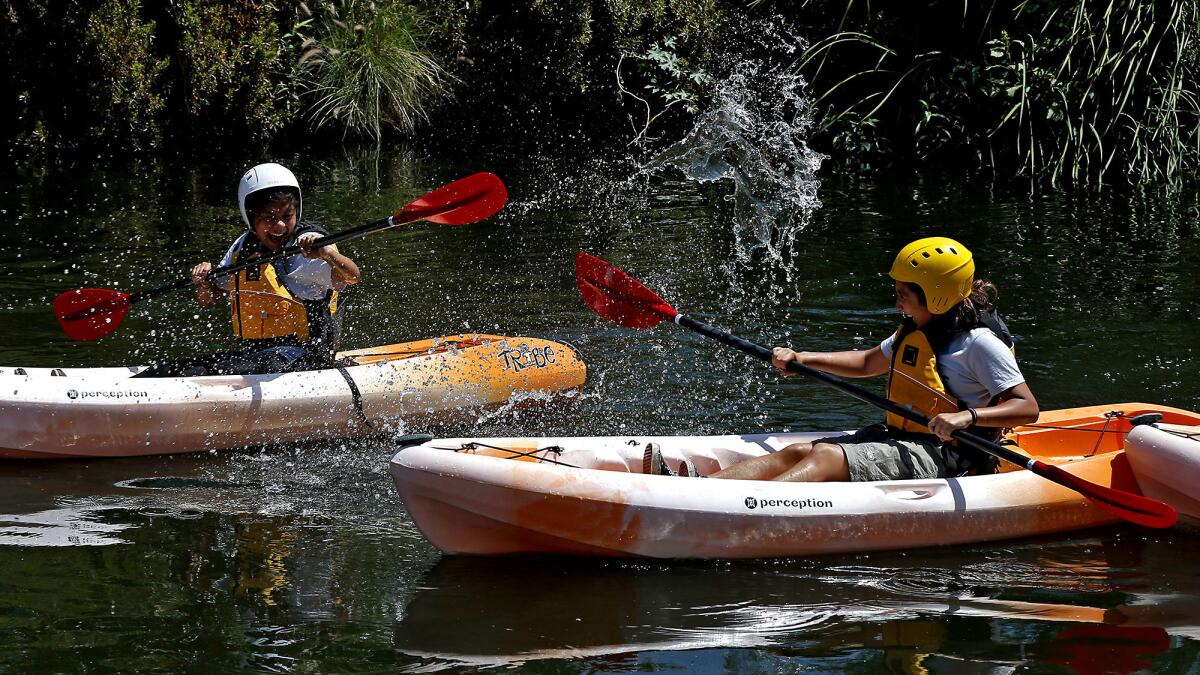Students grow a bond with nature through environmental internship

- Share via
Where the Los Angeles River’s concrete channels give way to soft riverbed, hawks, swifts and warblers fly overhead while ibises, owls and larks glide by once in a while. On Friday morning, a different species appeared: students kayaking through the water.
Three weeks ago, six Environmental Charter High School students abandoned their native urban home of Lawndale for the Santa Rosa Plateau to be immersed in nature. It was at first exotic (“Some of these girls have never seen stars in the sky or slept without hearing an airplane overhead,” said Lisa Park of the Nature Conservancy), but it soon began to feel like home.
“All of us rely on nature for the food we eat, the water we drink and the air we breathe. It’s one of our goals to show young people that connection,” said Brigitte Griswold, director of the group’s Leaders in Environmental Action for the Future.
The Nature Conservancy, based in Arlington, Va., runs a national program that has sent 150 students every summer since 1995 to conservation sites across the United States for paid internships intended to expose them to environmental careers.
Kaela Chantawansri, 17, gave it a go to see whether she wants to study environmental science in college.
“I’m not the type of person to sit in the office and do the same thing day after day,” Kaela said. “It’s really challenging, because sometimes it’s 100 degrees. It’s really hard, but it’s strengthening because of it.”
Through LEAF, the students have set traps for mountain lions to be caught, tagged and studied. They’ve hiked for miles, posted signs advising against illegal deer hunting and removed the slender green reeds known as Arundo donax, an invasive species.
They’ve also picked up life skills along the way; they now know how to clean, cook and budget money. For many of the students, it’s their first time living away from home.
On Friday, they found themselves near the intersection of Dover Street and Legion Lane in Atwater Village for a kickoff event to study the river’s biodiversity. The goal was to catalog water samples that will be compared with data collected from other ecosystems in cities such as Hong Kong, Jakarta, London and New York City.
Findings of the local ecosystem’s health will help guide a restoration plan following the U.S. Army Corps of Engineers’ recent recommendation to use $1 billion from federal, state and city governments to restore 11 miles of the river.
“We’re going to create what is ours. We’re going to create an oasis,” Democratic state Sen. Kevin de León said in remarks to the students on Friday.
He said it takes citizens to carry on the legacy as stewards of the land.
A survey from the Nature Conservancy found that one in three LEAF alumni go on to obtain degrees in environmental studies; the demand for environmental specialists is expected to grow 15% between 2012 and 2022, outpacing the national employment average, according to the U.S. Department of Labor.
“It shows students there’s actually work in this, and we’re not just crazy, tree-loving hippies, so they’re pursuing these fields,” said Mandy Breuer, assistant principal of Environmental Charter High.
Fostering a fondness for nature early in life helps achieve this, Griswold said.
“Young people are not exposed to nature in the same way as older generations,” she said. “When I was growing up, I had a cow named Hamburger. I always knew where my food was coming from. That’s not the world we live in anymore. You ask a young person where water comes from, they’ll probably say ‘The tap.’”
That’s not so for 18-year-old Michelle Cornejo, who sees the water of the Los Angeles River flowing from underground springs, urban runoff and melting snowpack. She’s solidified her bond with nature during her internship, learning how to take care of a brush with poison oak and an uncomfortable cut on her hand. She’s grown a lot, she said.
“If I step out of my comfort zone, I can learn something new,” Cornejo said. “I know so much more about myself.”
sara.hayden@latimes.com
Twitter: @haydensaraa
More to Read
Sign up for Essential California
The most important California stories and recommendations in your inbox every morning.
You may occasionally receive promotional content from the Los Angeles Times.













